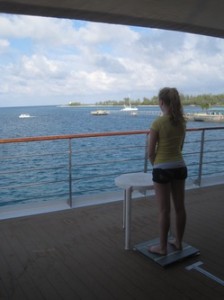 Body sway and posture correlate with the severity of seasickness experienced by novices on a ship, according to research in the open access journal PLOS ONE by Dr. Thomas Stoffregen, professor of kinesiology and director of the Affordance Perception-Action Laboratory, and colleagues from other institutions. Studying stance in a group of undergraduate students on a two-day cruise, the researchers found that maritime novices change their posture rapidly to ‘get their sea legs’. Like experienced mariners, novices at sea adjusted to being at sea by rapidly learning to use the horizon as a referent to stabilize the body at sea.
Body sway and posture correlate with the severity of seasickness experienced by novices on a ship, according to research in the open access journal PLOS ONE by Dr. Thomas Stoffregen, professor of kinesiology and director of the Affordance Perception-Action Laboratory, and colleagues from other institutions. Studying stance in a group of undergraduate students on a two-day cruise, the researchers found that maritime novices change their posture rapidly to ‘get their sea legs’. Like experienced mariners, novices at sea adjusted to being at sea by rapidly learning to use the horizon as a referent to stabilize the body at sea.
“People have been going to sea for thousands of years, but ours is the first scientific study of how people learn to control their bodies as they get their sea legs,” said Stoffregen.
Body sway correlated with experiences of seasickness. Individuals with greater body sway prior to the voyage experienced more severe seasickness while on board. Greater body sway while on the ship was associated with experiences of the rare condition of mal de debarquement, or disembarkment syndrome. Novices also widened their stance within the first 24 hours of the voyage. The authors suggest that susceptibility to seasickness may be related to individual differences in postural responses to the visible horizon.
Fu-Chen Chen, Manuel Varlet, Cristina Alcantara, and Benoît G. Bardy co-authored the publication with Stoffregen.
PLOS ONE publishes primary research from all areas of science and employs a combination of peer review and post-publication rating and commenting, to maximize the impact of every report it publishes. All works published in PLOS ONE are Open Access.
The full citation appears as follows:
Stoffregen TA, Chen F-C, Varlet M, Alcantara C, Bardy BG (2013) Getting Your Sea Legs. PLoS ONE 8(6): e66949. doi:10.1371/journal.pone.0066949



